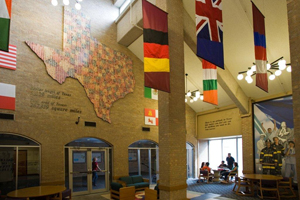Jester Center Gets Snazzy Updates After 41 Years

Its own ZIP code is gone, but beds for 3,066 people — more than in some entire Texas towns — remain.
Forty-one years later, Jester Center is still one of the largest residence halls any university has ever built. But the epic dorm has come a long way, especially in the past few years.
On Wednesday, the Housing and Food Service team that has transformed the look, feel, and food of Jester Center came together to celebrate its ambitious updates.
Among them: more windows, better lounges, renovated bathrooms, new service desks, powerful air handlers, a la carte dining, and a brand-new roof.
All those make a difference in the 866,000-square-foot hall's more modern atmosphere.
There came a turning point about five years ago, senior associate housing director Randy Porter said, when his division realized they would either have to come to terms with Jester's deferred maintenance or start to let it go so it could eventually be torn down.
Jester cost $17 million when it opened in 1969, and a comparable hall would cost $300 million to build now, Porter said. So Housing decided to start tackling the updates.
And they went above and beyond the physical needs, installing large-scale artwork as part of the Longhorn Art Series and a museum called the Gallery of Texas Cultures.
The Longhorn Art Series places in every residence hall a giclée reproduction of a painting that depicts Longhorns in their native state, roaming the Texas plains.
The Gallery of Texas Cultures highlights the 32 distinct ethnic groups, from Czechs to African Americans to Mexicans to Chinese, who have contributed to the settlement and growth of the state. It features flags, wall displays, and even maps built into the marmoleum floors — and it still allows space for students to study.
People from outside Texas ask Housing and Food Service executive director Floyd Hoelting about all the legends, he said — whether Jester is the world's largest residence hall, whether it has its own ZIP code, and whether parents who dropped their kids off six years ago are still lost somewhere in the building's basement.
Hoelting answers yes to everything, he said jovially. Myths are part of what makes Texas Texas.
"We've got halls with a lot of charm," Hoelting said, "but Jester's got the heartbeat of this University and this state."
People from the various groups who have contributed to Jester's updating, from administrators to builders, students to maintenance workers, cattlemen to curators, attended the ceremony. The diverse crowd encapsulated the "rich connectedness" UT offers, Hoelting said.
Former residents were there to testify that Jester had opened their world. "It was really a unique experience, to say the least," said Jennifer Calloway, who was a resident assistant in the hall from 1973-1975. She is now a high school counselor and Texas Exes Fayette County Chapter member back in her hometown of La Grange.
The legal drinking age of 18 made rule-enforcing a challenge, Calloway said. There were Vietnam protests and women's consciousness-raising meetings on campus all the time. There were locked doors between the men's and women's sides. Tuition was $150 a semester, and students looked things up in books, took notes on paper, and tapped out their findings on typewriters.
Bob Childress, now assistant director of the Division of Recreational Sports, was among Jester's first residents when it opened in 1969. He remembered "roughing it" without microwaves or refrigerators in the room. Some complained about the cafeteria-style food, he said, but he appreciated the steak and baked potato on Sundays.
"I worked here, played here, stayed here, had my classes right around here," he said. "Jester started me on this path."
Photo: The Gallery of Great Texas Cultures in Jester Center. Photo courtesy of the Division of Housing and Food Service.





